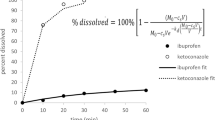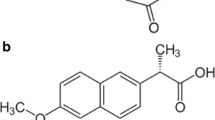Abstract
Purpose
We aim to present a refined thin-film model describing the drug particle dissolution considering radial diffusion in spherical boundary layer, and to demonstrate the ability of the model to describe the dissolution behavior of bulk drug powders.
Methods
The dissolution model introduced in this study was refined from a radial diffusion-based model previously published by our laboratory (So et al. in Pharm Res. 39:907–17, 2022). The refined model was created to simulate the dissolution of bulk powders, and to account for the evolution of particle size and diffusion layer thickness during dissolution. In vitro dissolution testing, using fractionated hydrochlorothiazide powders, was employed to assess the performance of the model.
Results
Overall, there was a good agreement between the experimental dissolution data and the predicted dissolution profiles using the proposed model across all size fractions of hydrochlorothiazide. The model over-predicted the dissolution rate when the particles became smaller. Notably, the classic Nernst-Brunner formalism led to an under-estimation of the dissolution rate. Additionally, calculation based on the equivalent particle size derived from the specific surface area substantially over-predicted the dissolution rate.
Conclusion
The study demonstrated the potential of the radial diffusion-based model to describe dissolution of drug powders. In contrast, the classic Nernst-Brunner equation could under-estimate drug dissolution rate, largely due to the underlying assumption of translational diffusion. Moreover, the study indicated that not all surfaces on a drug particle contribute to dissolution. Therefore, relying on the experimentally-determined specific surface area for predicting drug dissolution is not advisable.









Similar content being viewed by others
References
Dokoumetzidis A, Macheras P. A century of dissolution research: from Noyes and Whitney to the biopharmaceutics classification system. Int J Pharm. 2006;321(1–2):1–11.
Siepmann J, Siepmann F. Mathematical modeling of drug dissolution. Int J Pharm. 2013;453(1):12–24.
Nernst W. Theorie der Reaktionsgeschwindigkeit in heterogenen Systemen. Z Phys Chem. 1904;47(1):52–5.
Noyes AA, Whitney WR. The rate of solution of solid substances in their own solutions. J Am Chem Soc. 1897;19(12):930–4.
Sugano K. Aqueous boundary layers related to oral absorption of a drug: from dissolution of a drug to carrier mediated transport and intestinal wall metabolism. Mol Pharm. 2010;7(5):1362–73.
Armenante PM, Kirwan DJ. Mass transfer to microparticles in agitated systems. Chem Eng Sci. 1989;44(12):2781–96.
Assunção M, Vynnycky M, Moroney KM. On the dissolution of a solid spherical particle. Phys Fluids. 2023;35(5):053605.
Wang J, Flanagan DR. General solution for diffusion-controlled dissolution of spherical particles. 1. Theory. J Pharm Sci. 1999;88(7):731–8.
So C, Chiang P-C, Mao C. Modeling drug dissolution in 3-dimensional space. Pharm Res. 2022;39(5):907–17.
Wang J, Flanagan DR. General solution for diffusion-controlled dissolution of spherical particles. 2. Evaluation of experimental data. J Pharm Sci. 2002;91(2):534–42.
Crank J. The mathematics of diffusion. Bristol: Oxford University Press; 1975.
Anderberg E, Bisrat M, Nyström C. Physicochemical aspects of drug release. VII. The effect of surfactant concentration and drug particle size on solubility and dissolution rate of felodipine, a sparingly soluble drug. Int J Pharm. 1988;47(1–3):67–77.
Anderberg E, Nyström C. Physicochemical aspects of drug release: X. Investigation of the applicability of the cube root law for characterization of the dissolution rate of fine particulate materials. Int J Pharm. 1990;62(2–3):143–51.
Bisrat M, Nyström C. Physicochemical aspects of drug release. VIII. The relation between particle size and surface specific dissolution rate in agitated suspensions. Int J Pharm. 1988;47(1–3):223–31.
De Almeida LP, Simões S, Brito P, Portugal A, Figueiredo M. Modeling dissolution of sparingly soluble multisized powders. J Pharm Sci. 1997;86(6):726–32.
Hintz RJ, Johnson KC. The effect of particle size distribution on dissolution rate and oral absorption. Int J Pharm. 1989;51(1):9–17.
Chu KR, Lee E, Jeong SH, Park E-S. Effect of particle size on the dissolution behaviors of poorly water-soluble drugs. Arch Pharmacal Res. 2012;35:1187–95.
Avdeef A. Leakiness and size exclusion of paracellular channels in cultured epithelial cell monolayers-interlaboratory comparison. Pharm Res. 2010;27(3):480–9.
Grymonpré W, Verstraete G, Vanhoorne V, Remon JP, De Beer T, Vervaet C. Downstream processing from melt granulation towards tablets: In-depth analysis of a continuous twin-screw melt granulation process using polymeric binders. Eur J Pharm Biopharm. 2018;124:43–54.
Gray V, Kelly G, Xia M, Butler C, Thomas S, Mayock S. The science of USP 1 and 2 dissolution: present challenges and future relevance. Pharm Res. 2009;26:1289–302.
Higuchi WI. Diffusional models useful in biopharmaceutics: drug release rate processes. J Pharm Sci. 1967;56(3):315–24.
Sugano K. Introduction to computational oral absorption simulation. Expert Opin Drug Metab Toxicol. 2009;5(3):259–93.
Jia W, Yawman PD, Pandya KM, Sluga K, Ng T, Kou D, Nagapudi K, Luner PE, Zhu A, Zhang S, Hou HH. Assessing the interrelationship of microstructure, properties, drug release performance, and preparation process for amorphous solid dispersions via noninvasive imaging analytics and material characterization. Pharm Res. 2022;39(12):3137–54.
Levich VG. Physicochemical hydrodynamics:(by) veniamin G. Levich. Transl. by Scripta Technica, Inc. Englewood Cliffs: Prentice-Hall; 1962.
Shekunov B, Montgomery ER. Theoretical analysis of drug dissolution: I. Solubility and intrinsic dissolution rate. J Pharm Sci. 2016;105(9):2685–97.
Author information
Authors and Affiliations
Corresponding author
Ethics declarations
Competing Interests
The authors declare that they have no conflicts of interests.
Additional information
Publisher's Note
Springer Nature remains neutral with regard to jurisdictional claims in published maps and institutional affiliations.
Rights and permissions
Springer Nature or its licensor (e.g. a society or other partner) holds exclusive rights to this article under a publishing agreement with the author(s) or other rightsholder(s); author self-archiving of the accepted manuscript version of this article is solely governed by the terms of such publishing agreement and applicable law.
About this article
Cite this article
Salish, K., So, C., Jeong, S.H. et al. A Refined Thin-Film Model for Drug Dissolution Considering Radial Diffusion – Simulating Powder Dissolution. Pharm Res (2024). https://doi.org/10.1007/s11095-024-03696-0
Received:
Accepted:
Published:
DOI: https://doi.org/10.1007/s11095-024-03696-0




